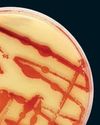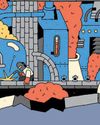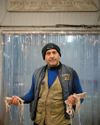
But unlike China, which locked down a province of more than 60 million people to try to stop the illness from spreading, Korea hasn’t put any curbs on internal movement in place, instead testing hundreds of thousands of people everywhere from clinics to drive-thru stations.
The testing blitz appears to be paying off in a lower-than-average mortality rate. The outbreak also shows signs of being largely contained in Daegu, the city about 150 miles south of Seoul where most of the country’s more than 7,700 infections have emerged.
It’s an approach born of bitter experience. An outbreak of Middle East respiratory syndrome in 2015 killed 38 people in South Korea. Because of a lack of kits to test for the MERS pathogen, infected patients went from hospital to hospital seeking help, spreading the virus widely. Afterward, the country created a system to allow rapid approval of testing kits for viruses that have the potential to cause pandemics.
Denne historien er fra March 16, 2020-utgaven av Bloomberg Businessweek.
Start din 7-dagers gratis prøveperiode på Magzter GOLD for å få tilgang til tusenvis av utvalgte premiumhistorier og 9000+ magasiner og aviser.
Allerede abonnent ? Logg på
Denne historien er fra March 16, 2020-utgaven av Bloomberg Businessweek.
Start din 7-dagers gratis prøveperiode på Magzter GOLD for å få tilgang til tusenvis av utvalgte premiumhistorier og 9000+ magasiner og aviser.
Allerede abonnent? Logg på

Instagram's Founders Say It's Time for a New Social App
The rise of AI and the fall of Twitter could create opportunities for upstarts

Running in Circles
A subscription running shoe program aims to fight footwear waste

What I Learned Working at a Hawaiien Mega-Resort
Nine wild secrets from the staff at Turtle Bay, who have to manage everyone from haughty honeymooners to go-go-dancing golfers.

How Noma Will Blossom In Kyoto
The best restaurant in the world just began its second pop-up in Japan. Here's what's cooking

The Last-Mover Problem
A startup called Sennder is trying to bring an extremely tech-resistant industry into the age of apps

Tick Tock, TikTok
The US thinks the Chinese-owned social media app is a major national security risk. TikTok is running out of ways to avoid a ban

Cleaner Clothing Dye, Made From Bacteria
A UK company produces colors with less water than conventional methods and no toxic chemicals

Pumping Heat in Hamburg
The German port city plans to store hot water underground and bring it up to heat homes in the winter

Sustainability: Calamari's Climate Edge
Squid's ability to flourish in warmer waters makes it fitting for a diet for the changing environment

New Money, New Problems
In Naples, an influx of wealthy is displacing out-of-towners lower-income workers